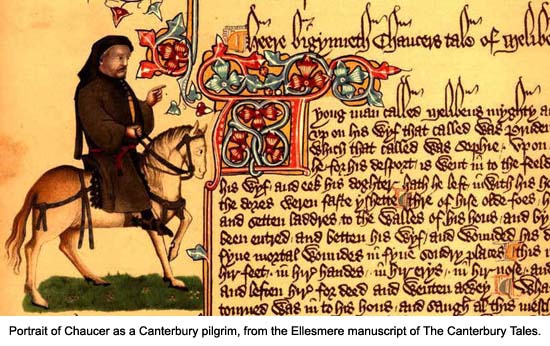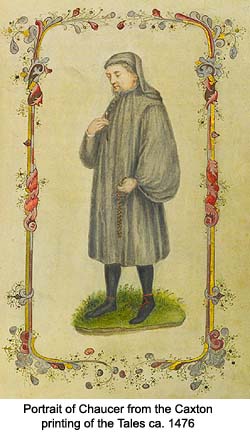The Canterbury Tales
The Canterbury Tales is a collection of stories written by
Geoffrey Chaucer in the 14th century (two of them in prose, the
rest in verse). The tales, some of which are originals and others
not, are contained inside a frame tale and told by a group of
pilgrims on their way from Southwark to Canterbury to visit the
shrine of Saint Thomas à Becket at Canterbury Cathedral.
The Canterbury Tales are written in Middle English.
The themes of the tales vary, and include topics such as
courtly love, treachery and avarice. The genres also vary, and
include romance, Breton lai, sermon, and fabliau. The characters,
introduced in the General Prologue of the book, tell tales of
great cultural relevance.

Some of the tales are serious and others humorous; however,
all are very precise in describing the traits and faults of human
nature. Religious malpractice is a major theme as well as
focusing on the division of the three estates. Most of the tales
are interlinked with similar themes running through them and some
are told in retaliation for other tales in the form of an
argument. The work is incomplete, as it was originally intended
that each character would tell four tales, two on the way to
Canterbury and two on the return journey. This would have meant a
possible 120 tales, which would have dwarfed the 26 tales
actually written.
People have sought political overtones within the tales,
particularly as Chaucer himself was a significant courtier and
political figure at the time, close to the corridors of power.
There are many hints at contemporary events, although few are
proven, and the theme of marriage common in the tales is presumed
to refer to several different marriages, most often those of John
of Gaunt. Aside from Chaucer himself, Harry Bailly of the Tabard
Inn was a real person and the Cook has been identified as quite
likely to be Roger Knight de Ware, a contemporary London
cook.
The Canterbury Tales can also tell modern readers much
about "the occult" during Chaucer's time, especially in
regards to astrology and the astrological lore prevalent during
Chaucer's era. There are hundreds if not thousands of
astrological allusions found in this work; some are quite overt
while others are more covert in nature.
The idea of a pilgrimage appears to have been mainly a useful
device to get such a diverse collection of people together for
literary purposes. The Monk would probably not be allowed to
undertake the pilgrimage and some of the other characters would
be unlikely ever to want to attend. Also all of the pilgrims ride
horses, there is no suggestion of them suffering for their
religion. None of the popular shrines along the way are visited
and there is no suggestion that anyone attends mass, so that it
seems much more like a tourist's jaunt.
 Chaucer does not pay that much attention to the
progress of the trip. He hints that the tales take several days
but he does not detail any overnight stays. Although the journey
could be done in one day this speed would make telling tales
difficult and three to four days was the usual duration for such
pilgrimages. The 18th of April is mentioned in the tales and
Walter William Skeat, a 19th century editor, determined 17 April
1387 as the probable first day of the tales. Chaucer does not pay that much attention to the
progress of the trip. He hints that the tales take several days
but he does not detail any overnight stays. Although the journey
could be done in one day this speed would make telling tales
difficult and three to four days was the usual duration for such
pilgrimages. The 18th of April is mentioned in the tales and
Walter William Skeat, a 19th century editor, determined 17 April
1387 as the probable first day of the tales.
The work was begun some time in the 1380s with Chaucer stopping
work on it in the late 1390s. It was not written down fully
conceived: it seems to have had many revisions with the addition
of new tales at various times. The plan for 120 tales is from the
general prologue. It is announced by Harry Bailly, the host, that
there will be four tales each. This is not necessarily the
opinion of Chaucer himself, who appears as the only character to
tell more than one tale. It has been suggested that the
unfinished state was deliberate on Chaucer's part.
The structure of The Canterbury Tales is easy to find in
other contemporary works, such as The Book of Good Love by
Juan Ruiz and Boccaccio's Decameron, which may have been
one of Chaucer's main sources of inspiration. Chaucer indeed
adapted several of Boccaccio's stories to put in the mouths of
his own pilgrims, but what sets Chaucer's work apart from his
contemporaries' is his characters. Compared to Boccaccio's main
characters -- seven women and three men, all young, fresh and
well-to-do, and given Classical names -- the characters in
Chaucer are of extremely varied stock, including representatives
of most of the branches of the middle classes at that time. Not
only are the participants very different, but they tell very
different types of tales, with their personalities showing
through both in their choices of tales and in the way they tell
them.
It is sometimes argued that the greatest contribution that this
work made to English literature was in popularising the literary
use of the vernacular language, English (rather than French or
Latin). However, several of Chaucer's contemporaries -- John
Gower, William Langland, and the Pearl Poet -- also wrote major
literary works in English, making it unclear how much Chaucer was
responsible for starting a trend rather than simply being part of
it.
Two early manuscripts of the tale are the Hengwrt manuscript and
the Ellesmere manuscript. Altogether, the Tales survives in 84
manuscripts and four printed editions dating from before 1500.
In 2004, Professor Linne Mooney was able to identify the
scrivener who worked for Chaucer as an Adam Pinkhurst. Professor
Mooney, working at the University of Cambridge, was able to match
Pinkhurst's signature on an oath he signed to his lettering on a
copy of The Canterbury Tales that was transcribed from Chaucer's
working copy.
Scholars divide the tales into ten fragments. The tales that make
up a fragment are directly connected, usually with one character
speaking to and handing over to another character, but there is
no connection between most of the other fragments. This means
that there are several possible permutations for the order of the
fragments and consequently the tales themselves. The listing
below is perhaps the most common in modern times. It is assumed
that Chaucer would have amended his manuscript or inserted more
tales to fill the time.
The Tales:
- The General Prologue
- The Knight's Tale
- The Miller's Prologue and Tale
- The Reeve's Prologue and Tale
- The Cook's Prologue and Tale
- The Man of Law's Prologue and Tale
- The Wife of Bath's Prologue and Tale
- The Friar's Prologue and Tale
- The Summoner's Prologue and Tale
- The Clerk's Prologue and Tale
- The Merchant's Prologue and Tale
- The Squire's Prologue and Tale
- The Franklin's Prologue and Tale
- The Physician's Tale
- The Pardoner's Prologue and Tale
- The Shipman's Tale
- The Prioress' Prologue and Tale
- Chaucer's Tale of Sir Topas
- The Tale of Melibee
- The Monk's Prologue and Tale
- The Nun's Priest's Prologue and Tale
- The Second Nun's Prologue and Tale
- The Canon's Yeoman's Prologue and Tale
- The Manciple's Prologue and Tale
- The Parson's Prologue and Tale
- Chaucer's Retraction
Related Articles:
- Canterbury: Still the Perfect Pilgrimage!, by Julia Hickey
- https://www.timetravel-britain.com/articles/towns/canterbury.shtml
- Canterbury Cathedral, by John P. Seely
- https://www.timetravel-britain.com/articles/churches/canterbury.shtml
More Information:
We regret that we no longer have the resources to maintain up-to-date links and/or hours and pricing details for the various sites and attractions listed on this website. For more information about the location(s) listed above, please use your favorite search engine or visit Wikipedia.
Article reprinted from Wikipedia.org
| 